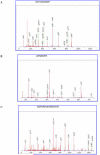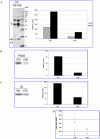A gel-based proteomic comparison of human cerebrospinal fluid between inflicted and non-inflicted pediatric traumatic brain injury
- PMID: 17263669
- PMCID: PMC2721471
- DOI: 10.1089/neu.2006.0061
A gel-based proteomic comparison of human cerebrospinal fluid between inflicted and non-inflicted pediatric traumatic brain injury
Abstract
Traumatic brain injury (TBI) is the most common cause of traumatic death in infancy, and inflicted TBI (iTBI) is the predominant cause. Like other central nervous system pathologies, TBI changes the composition of cerebrospinal fluid (CSF), which may represent a unique clinical window on brain pathophysiology. Proteomic analysis, including two-dimensional (2-D) difference in gel electrophoresis (DIGE) combined with mass spectrometry (MS), was used to compare the CSF protein profile of two pooled samples from pediatric iTBI (n = 13) and non-inflicted TBI (nTBI; n = 13) patients with severe injury. CSF proteins from iTBI and nTBI were fluorescently labeled in triplicate using different fluorescent Cy dyes and separated by 2-D gel electrophoresis. Approximately 250 protein spots were found in CSF, with 90% between-gel reproducibility of the 2-D gel. Following in-gel digestion, the tryptic peptides were analyzed by MS for protein identification. The acute phase reactant, haptoglobin (HP) isoforms, showed an approximate fourfold increase in nTBI versus iTBI. In contrast, the levels of prostaglandin D(2) synthase (PGDS) and cystatin C (CC) were 12-fold and sevenfold higher in iTBI versus nTBI, respectively. The changes of HP, PGDS, and CC were confirmed by Western blot. These initial results with conventional gel-based proteomics show new protein changes that may ultimately help to understand pathophysiological differences between iTBI and nTBI.
Figures



Similar articles
-
Neuron-specific enolase and S100B in cerebrospinal fluid after severe traumatic brain injury in infants and children.Pediatrics. 2002 Feb;109(2):E31. doi: 10.1542/peds.109.2.e31. Pediatrics. 2002. PMID: 11826241
-
Assessment of the macrophage marker quinolinic acid in cerebrospinal fluid after pediatric traumatic brain injury: insight into the timing and severity of injury in child abuse.J Neurotrauma. 2004 Sep;21(9):1123-30. doi: 10.1089/neu.2004.21.1123. J Neurotrauma. 2004. PMID: 15453983
-
Cerebrospinal fluid biomarkers versus glasgow coma scale and glasgow outcome scale in pediatric traumatic brain injury: the role of young age and inflicted injury.J Neurotrauma. 2007 Jan;24(1):75-86. doi: 10.1089/neu.2006.0062. J Neurotrauma. 2007. PMID: 17263671
-
Biochemical markers of brain injury: could they be used as diagnostic adjuncts in cases of inflicted traumatic brain injury?Child Abuse Negl. 2004 Jul;28(7):739-54. doi: 10.1016/j.chiabu.2004.01.007. Child Abuse Negl. 2004. PMID: 15261469 Review.
-
Proteomics analysis of human cerebrospinal fluid.J Chromatogr B Analyt Technol Biomed Life Sci. 2005 Feb 5;815(1-2):179-89. doi: 10.1016/j.jchromb.2004.06.044. J Chromatogr B Analyt Technol Biomed Life Sci. 2005. PMID: 15652808 Review.
Cited by
-
Detection of structural and metabolic changes in traumatically injured hippocampus by quantitative differential proteomics.J Neurotrauma. 2013 May 1;30(9):775-88. doi: 10.1089/neu.2012.2391. Epub 2012 Sep 20. J Neurotrauma. 2013. PMID: 22757692 Free PMC article.
-
Current and Emerging Technologies for Probing Molecular Signatures of Traumatic Brain Injury.Front Neurol. 2017 Aug 30;8:450. doi: 10.3389/fneur.2017.00450. eCollection 2017. Front Neurol. 2017. PMID: 28912750 Free PMC article. Review.
-
Acute Phase Proteins in Cerebrospinal Fluid from Dogs with Naturally-Occurring Spinal Cord Injury.J Neurotrauma. 2015 Nov 1;32(21):1658-65. doi: 10.1089/neu.2015.3895. Epub 2015 Jul 17. J Neurotrauma. 2015. PMID: 26186466 Free PMC article.
-
Screening of biochemical and molecular mechanisms of secondary injury and repair in the brain after experimental blast-induced traumatic brain injury in rats.J Neurotrauma. 2013 Jun 1;30(11):920-37. doi: 10.1089/neu.2013.2862. Epub 2013 Jun 5. J Neurotrauma. 2013. PMID: 23496248 Free PMC article.
-
Metabolic crisis after traumatic brain injury is associated with a novel microdialysis proteome.Neurocrit Care. 2010 Jun;12(3):324-36. doi: 10.1007/s12028-010-9342-5. Neurocrit Care. 2010. PMID: 20225002 Free PMC article.
References
-
- ABRAHAMSON M, BARRETT AJ, SALVESEN G, GRUBB A. Isolation of six cysteine proteinase inhibitors from human urine. Their physicochemical and enzyme kinetic properties and concentrations in biological fluids. J. Biol. Chem. 1986;261:11282–11289. - PubMed
-
- ADELSON PD, KOCHANEK PM. Head injury in children. J. Child Neurol. 1998;13:2–15. - PubMed
-
- ALDRED AR, BRACK CM, SCHREIBER G. The cerebral expression of plasma protein genes in different species. Comp. Biochem. Physiol. B Biochem. Mol. Biol. 1995;111:1–15. - PubMed
-
- AMICK JE, YANDORA KA, BELL MJ, et al. The Th1 versus Th2 cytokine profile in cerebrospinal fluid after severe traumatic brain injury in infants and children. Pediatr. Crit. Care Med. 2001;2:260–264. - PubMed
-
- BELL MJ, KOCHANEK PM, DOUGHTY LA, et al. Interleukin-6 and interleukin-10 in cerebrospinal fluid after severe traumatic brain injury in children. J. Neurotrauma. 1997;14:451–457. - PubMed
Publication types
MeSH terms
Substances
Grants and funding
- UL1 TR000005/TR/NCATS NIH HHS/United States
- R01 NS042648/NS/NINDS NIH HHS/United States
- P01 NS030318/NS/NINDS NIH HHS/United States
- K23 HD043843/HD/NICHD NIH HHS/United States
- NS 30318/NS/NINDS NIH HHS/United States
- P50 NS030318/NS/NINDS NIH HHS/United States
- T32 HD040686/HD/NICHD NIH HHS/United States
- HD 40686/HD/NICHD NIH HHS/United States
- U54 DA 021519/DA/NIDA NIH HHS/United States
- NS 42648/NS/NINDS NIH HHS/United States
- U54 DA021519/DA/NIDA NIH HHS/United States
- NS 38087/NS/NINDS NIH HHS/United States
- R01 NS038087/NS/NINDS NIH HHS/United States
- K23 HD 043843-01/HD/NICHD NIH HHS/United States
LinkOut - more resources
Full Text Sources
Other Literature Sources
Medical
Research Materials
Miscellaneous

